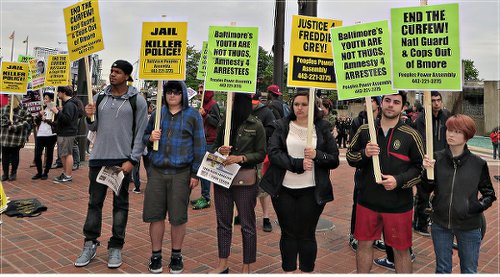

International Workers Day in Baltimore. Protesters defend rebellious youths.WW photo: Monica Moorehead


International Workers Day in Baltimore. Protesters defend rebellious youths.
WW photo: Monica Moorehead
It is no coincidence that Baltimore’s state attorney, Marilyn Mosby, announced on May 1 that six police officers had been indicted and arrested for the murder of Freddie Grey, a day before a major march and rally had been scheduled to protest a lack of indictments and arrests of police since Grey’s death.
An official autopsy on Grey has not been released yet, although it is public knowledge that at least 80 percent of his spine had been severed between the time of his arrest on April 12 and when he lapsed into a coma and died on April 19. The charges against the officers, three white and three Black, range from involuntary manslaughter to second degree depraved heart murder, the latter charge meaning indifference to human life.
The Fraternal Order of Police in Baltimore and legal experts have criticized the indictments, claiming that there is a “conflict of interest” between Mosby and her spouse, Nick Mosby, a member of the local city council who represents the district where Grey lived. These critics also say that because there are no known eyewitnesses forthcoming in saying exactly what happened to Grey in the police van, convictions of the accused police officers will be next to impossible. The police have called for a special prosecutor to replace Mosby, who is African American.
The fact that any indictments against the police occurred at all is unprecedented. This is especially true in a majority Black inner city like Baltimore, where police terror including occupation is systemic and has lasted for decades. Over the past three years, close to $6 million in compensation has been paid to victims who brought legal suits against the Baltimore Police Department for its brutality.
The rebellion that took place in West Baltimore and then spread to East Baltimore’s commercial area on April 27 may have been ignited by Grey’s death, but it was a culmination of many years of pent up anger and frustration on the part of Black youth, who have been treated like prisoners in their own community. The cops have been their jailers and occupiers.
Police riot caused rebellion
Eyewitnesses state that the police sparked the rebellion when they shut down the only way out of the area, closing off a nearby subway and major bus depot that hundreds of students use to get home from the nearby school. Cutting off this path trapped the students.
Based on police rumors of a march from the high school, cops surrounded and trapped huge numbers of people in the area. Police have spread such rumors in the past to cause confusion and dissension among the masses and within the movement.
Recently, cops spread a rumor that the Bloods and Crips youth gangs had united to put out a contract to kill police. This was a lie. The truth was that these youth gangs had announced a truce with each other in order to unite and protest police repression. They had marched together at an April 25 protest.
Following Grey’s April 27 funeral, people as young as 12 years old were confronted with pepper pellets, a form of rubber bullets. One of these pellets struck a reporter, Shawn Carrié, on the scene. The reporter was later arrested and spent 49 hours in jail, according to the May 2 issue of The Guardian. (theguardian.com)
Stores at the Mondawmin Mall had windows smashed. Youth then escaped the police and headed to nearby Pennsylvania Avenue, the closest commercial area, and finally to the intersection of North and Pennsylvania avenues in the Black community.
WW correspondent Lamont Lilly, an eyewitness to the rebellion, described the conditions he saw in Baltimore: “When you take your time and walk by foot, the intense degree of poverty completely paralyzes you. It shocked me, and I’m from the hood. The absurd amount of boarded homes is astounding. The makeshift neighborhoods, comprised of trash, forgotten debris and the countless number of dilapidated buildings, are an absolute travesty in this, the richest country on the planet.
“The lack of grocery stores, playgrounds and recreation facilities is apparent. The community’s once beloved primary school was closed last year. The wasting away of Black bodies, good people and buried hope. The emphasis on protecting property over suffering people. While Freddie Grey was laid to rest today, these are the images that remain.” (workers.org, April 28)
As has been stated by People’s Power Assembly organizers, while the battle is far from over, the people in the street recognize that the indictments announced by the State’s Attorney’s Office were a direct result of the youth rebellion and the continuous protests led by the community since Freddie Grey’s death, which have been spectacular and ongoing. The PPA is calling for a people’s tribunal against police violence and structural racism to be held in Baltimore on June 6.
As part of Workers World newspaper’s coverage marking the 50th anniversary of the liberation of…
From the PFLP Central Media Office The following statement from the Popular Front for the…
Newark, New Jersey Over 250 people, representing over 250 New Jersey endorsing community groups, attended…
Special to Workers World The following is a press release issued on April 24, 2025,…
dear Larry Krasner, we heard you sued Elon Musk over his corrupt million election giveaways…
Unions join forces against harassment and deportation of members When 200 immigrant workers – from…